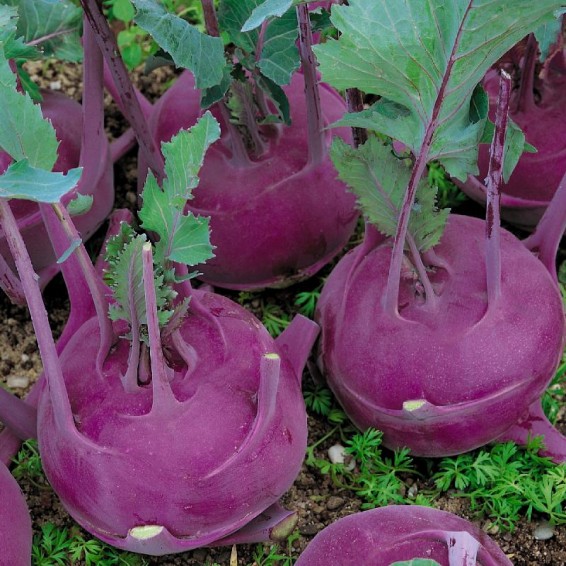Organic Purple Vienna Kohlrabi Seeds
Brassica oleracea
- HOW TO GROW
- FAST FACTS
HOW TO GROW
Sowing: Though kohlrabi grows best in cool weather, a continuous crop from spring to fall will grow in most climates. Direct sow the seed in rich soil and full sun 2-3 months before the last spring frost, or when the average soil temperature reaches at least 50 degrees F. Plant the seeds 1/4" deep with ten seeds per foot; thin plants to 5" apart in rows 1' apart. For a continuous crop, plant new seed every few weeks until six weeks before the first frost of autumn. Gardeners with the benefit of warmer winters can plant seed in late winter for an early spring crop. For companion planting benefits, plant kohlrabi with onions, beets, or cucumbers; avoid planting it with strawberries or tomatoes.
Growing: Success with kohlrabi depends on adequate moisture and good soil; the best flavor and tenderness are achieved when kohlrabi is able to grow quickly. Keep the soil moist and control weeds by applying mulch. Watch out for aphids, maggots, and other pests that will damage the crop.
Harvesting: For best tenderness, harvest kohlrabi when their diameter reaches a size of 2-3 inches. Pull the whole plant and remove the leaves and roots. Kohlrabi keep well in the refrigerator for up to a month.
Seed Saving: Since kohlrabi will cross pollinate with other members of the cabbage family such as broccoli or cauliflower, separate it to preserve genetic purity. Late in the fall, dig up the plants being saved for seed; remove the leaves and stem, and cut the root to 4-6" long. Keep the plants in moist sand at a temperature of about 40 degrees F. Replant the best plants 4-6 weeks before the last spring frost. The stem will grow about 4-5' tall, with many four petaled yellow flowers. Allow the flowers to mature; when the seed pods form, pick them and allow them to dry. Remove them from the pods and store them in a dry, cool place for up to five years.
FAST FACTS
Latin Name: Brassica oleracea
Type: Open Pollinated, Heirloom, Cool Season
USDA Zones: 3, 4, 5, 6, 7, 8, 9, 10, 11, 12
Seeds per Ounce: 9,000
Planting Method: Direct Sow
Planting Depth: 0.25
Planting Spacing: 6
Row Spacing: 16
Days to Maturity: 60
Sunlight: Full Sun
Height: 16 Inches
Color: Purple
DESCRIPTION
HOW TO GROW
Sowing: Though kohlrabi grows best in cool weather, a continuous crop from spring to fall will grow in most climates. Direct sow the seed in rich soil and full sun 2-3 months before the last spring frost, or when the average soil temperature reaches at least 50 degrees F. Plant the seeds 1/4" deep with ten seeds per foot; thin plants to 5" apart in rows 1' apart. For a continuous crop, plant new seed every few weeks until six weeks before the first frost of autumn. Gardeners with the benefit of warmer winters can plant seed in late winter for an early spring crop. For companion planting benefits, plant kohlrabi with onions, beets, or cucumbers; avoid planting it with strawberries or tomatoes.
Growing: Success with kohlrabi depends on adequate moisture and good soil; the best flavor and tenderness are achieved when kohlrabi is able to grow quickly. Keep the soil moist and control weeds by applying mulch. Watch out for aphids, maggots, and other pests that will damage the crop.
Harvesting: For best tenderness, harvest kohlrabi when their diameter reaches a size of 2-3 inches. Pull the whole plant and remove the leaves and roots. Kohlrabi keep well in the refrigerator for up to a month.
Seed Saving: Since kohlrabi will cross pollinate with other members of the cabbage family such as broccoli or cauliflower, separate it to preserve genetic purity. Late in the fall, dig up the plants being saved for seed; remove the leaves and stem, and cut the root to 4-6" long. Keep the plants in moist sand at a temperature of about 40 degrees F. Replant the best plants 4-6 weeks before the last spring frost. The stem will grow about 4-5' tall, with many four petaled yellow flowers. Allow the flowers to mature; when the seed pods form, pick them and allow them to dry. Remove them from the pods and store them in a dry, cool place for up to five years.
FAST FACTS
Latin Name: Brassica oleracea
Type: Open Pollinated, Heirloom, Cool Season
USDA Zones: 3, 4, 5, 6, 7, 8, 9, 10, 11, 12
Seeds per Ounce: 9,000
Planting Method: Direct Sow
Planting Depth: 0.25
Planting Spacing: 6
Row Spacing: 16
Days to Maturity: 60
Sunlight: Full Sun
Height: 16 Inches
Color: Purple





